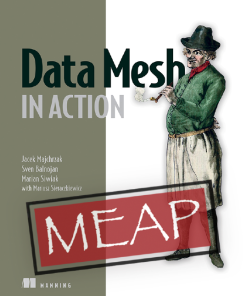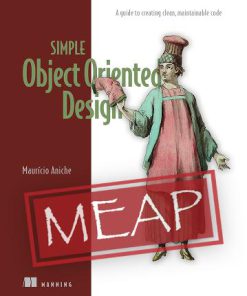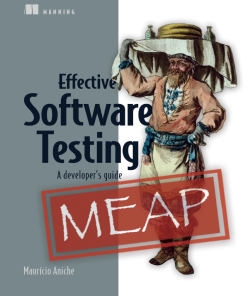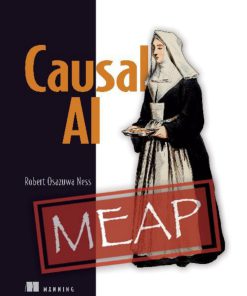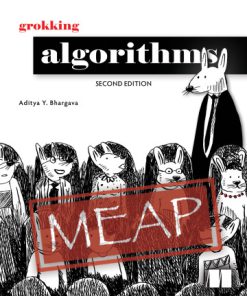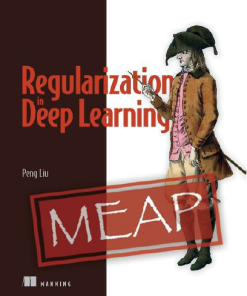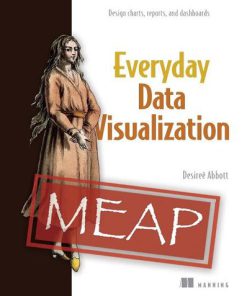Engineering Deep Learning Systems 1st Edition by Chi Wang, Donald Szeto ISBN 9781633439863 1633439860
$50.00 Original price was: $50.00.$25.00Current price is: $25.00.
Engineering Deep Learning Systems 1st Edition by Chi Wang, Donald Szeto – Ebook PDF Instant Download/Delivery: 9781633439863 ,1633439860
Full download Engineering Deep Learning Systems 1st Edition after payment
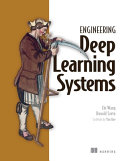
Product details:
ISBN 10: 1633439860
ISBN 13: 9781633439863
Author: Chi Wang, Donald Szeto
Engineering Deep Learning Systems 1st Edition Table of contents:
1 An introduction to deep learning systems
1.1 The deep learning development cycle
1.1.1 Phases in the deep learning product development cycle
1.1.2 Roles in the development cycle
1.1.3 Deep learning development cycle walk-through
1.1.4 Scaling project development
1.2 Deep learning system design overview
1.2.1 Reference system architecture
1.2.2 Key components
1.2.3 Key user scenarios
1.2.4 Derive your own design
1.2.5 Building components on top of Kubernetes
1.3 Building a deep learning system vs. developing a model
Summary
2 Dataset management service
2.1 Understanding dataset management service
2.1.1 Why deep learning systems need dataset management
2.1.2 Dataset management design principles
2.1.3 The paradoxical character of datasets
2.2 Touring a sample dataset management service
2.2.1 Playing with the sample service
2.2.2 Users, user scenarios, and the big picture
2.2.3 Data ingestion API
2.2.4 Training dataset fetching API
2.2.5 Internal dataset storage
2.2.6 Data schemas
2.2.7 Adding new dataset type (IMAGE_CLASS)
2.2.8 Service design recap
2.3 Open source approaches
2.3.1 Delta Lake and Petastorm with Apache Spark family
2.3.2 Pachyderm with cloud object storage
Summary
3 Model training service
3.1 Model training service: Design overview
3.1.1 Why use a service for model training?
3.1.2 Training service design principles
3.2 Deep learning training code pattern
3.2.1 Model training workflow
3.2.2 Dockerize model training code as a black box
3.3 A sample model training service
3.3.1 Play with the service
3.3.2 Service design overview
3.3.3 Training service API
3.3.4 Launching a new training job
3.3.5 Updating and fetching job status
3.3.6 The intent classification model training code
3.3.7 Training job management
3.3.8 Troubleshooting metrics
3.3.9 Supporting new algorithm or new version
3.4 Kubeflow training operators: An open source approach
3.4.1 Kubeflow training operators
3.4.2 Kubernetes operator/controller pattern
3.4.3 Kubeflow training operator design
3.4.4 How to use Kubeflow training operators
3.4.5 How to integrate these operators into an existing system
3.5 When to use the public cloud
3.5.1 When to use a public cloud solution
3.5.2 When to build your own training service
Summary
4 Distributed training
4.1 Types of distributed training methods
4.2 Data parallelism
4.2.1 Understanding data parallelism
4.2.2 Multiworker training challenges
4.2.3 Writing distributed training (data parallelism) code for different training frameworks
4.2.4 Engineering effort in data parallel–distributed training
4.3 A sample service supporting data parallel–distributed training
4.3.1 Service overview
4.3.2 Playing with the service
4.3.3 Launching training jobs
4.3.4 Updating and fetching the job status
4.3.5 Converting the training code to run distributedly
4.3.6 Improvements
4.4 Training large models that can’t load on one GPU
4.4.1 Traditional methods: Memory saving
4.4.2 Pipeline model parallelism
4.4.3 How software engineers can support pipeline parallelism
Summary
5 Hyperparameter optimization service
5.1 Understanding hyperparameters
5.1.1 What is a hyperparameter?
5.1.2 Why are hyperparameters important?
5.2 Understanding hyperparameter optimization
5.2.1 What is HPO?
5.2.2 Popular HPO algorithms
5.2.3 Common automatic HPO approaches
5.3 Designing an HPO service
5.3.1 HPO design principles
5.3.2 A general HPO service design
5.4 Open source HPO libraries
5.4.1 Hyperopt
5.4.2 Optuna
5.4.3 Ray Tune
5.4.4 Next steps
Summary
6 Model serving design
6.1 Explaining model serving
6.1.1 What is a machine learning model?
6.1.2 Model prediction and inference
6.1.3 What is model serving?
6.1.4 Model serving challenges
6.1.5 Model serving terminology
6.2 Common model serving strategies
6.2.1 Direct model embedding
6.2.2 Model service
6.2.3 Model server
6.3 Designing a prediction service
6.3.1 Single model application
6.3.2 Multitenant application
6.3.3 Supporting multiple applications in one system
6.3.4 Common prediction service requirements
Summary
7 Model serving in practice
7.1 A model service sample
7.1.1 Play with the service
7.1.2 Service design
7.1.3 The frontend service
7.1.4 Intent classification predictor
7.1.5 Model eviction
7.2 TorchServe model server sample
7.2.1 Playing with the service
7.2.2 Service design
7.2.3 The frontend service
7.2.4 TorchServe backend
7.2.5 TorchServe API
7.2.6 TorchServe model files
7.2.7 Scaling up in Kubernetes
7.3 Model server vs. model service
7.4 Touring open source model serving tools
7.4.1 TensorFlow Serving
7.4.2 TorchServe
7.4.3 Triton Inference Server
7.4.4 KServe and other tools
7.4.5 Integrating a serving tool into an existing serving system
7.5 Releasing models
7.5.1 Registering a model
7.5.2 Loading an arbitrary version of a model in real time with a prediction service
7.5.3 Releasing the model by updating the default model version
7.6 Postproduction model monitoring
7.6.1 Metric collection and quality gate
7.6.2 Metrics to collect
Summary
8 Metadata and artifact store
8.1 Introducing artifacts
8.2 Metadata in a deep learning context
8.2.1 Common metadata categories
8.2.2 Why manage metadata?
8.3 Designing a metadata and artifacts store
8.3.1 Design principles
8.3.2 A general metadata and artifact store design proposal
8.4 Open source solutions
8.4.1 ML Metadata
8.4.2 MLflow
8.4.3 MLflow vs. MLMD
Summary
9 Workflow orchestration
9.1 Introducing workflow orchestration
9.1.1 What is workflow?
9.1.2 What is workflow orchestration?
9.1.3 The challenges for using workflow orchestration in deep learning
9.2 Designing a workflow orchestration system
9.2.1 User scenarios
9.2.2 A general orchestration system design
9.2.3 Workflow orchestration design principles
9.3 Touring open source workflow orchestration systems
9.3.1 Airflow
9.3.2 Argo Workflows
9.3.3 Metaflow
9.3.4 When to use
Summary
10 Path to production
10.1 Preparing for productionization
10.1.1 Research
10.1.2 Prototyping
10.1.3 Key takeaways
10.2 Model productionization
10.2.1 Code componentization
10.2.2 Code packaging
10.2.3 Code registration
10.2.4 Training workflow setup
10.2.5 Model inferences
10.2.6 Product integration
10.3 Model deployment strategies
10.3.1 Canary deployment
10.3.2 Blue-green deployment
10.3.3 Multi-armed bandit deployment
People also search for Engineering Deep Learning Systems 1st Edition:
deep learning umich
deep-learning tech
deep learning in software engineering
reinforcement learning engineers
open systems engineering
You may also like…
Networking & Cloud Computing
Computers - Programming
Computers - Programming
Computers - Artificial Intelligence (AI)
Computadoras y Tecnología
Java Persistence with Spring Data and Hibernate (MEAP V04) Cătălin Tudose
Computers - Algorithms and Data Structures
grokking Algorithms MEAP V04 2nd Edition by Aditya Y Bhargava ISBN 1633438538 9781633438538
Computers - Artificial Intelligence (AI)
Computers - Algorithms and Data Structures
Computers - Professionals
Lead Developer Career Guide MEAP V04 1st Edition by Shelley Benhoff ISBN 1633438074 9781633438071



